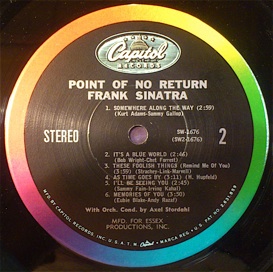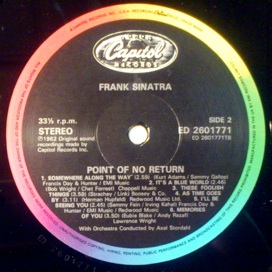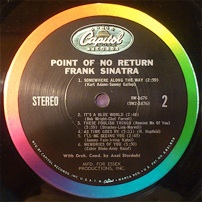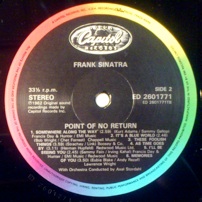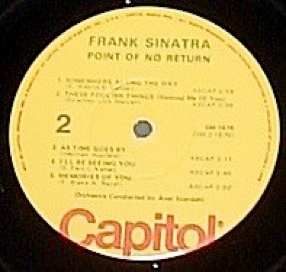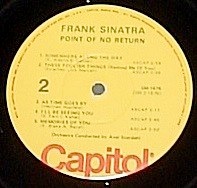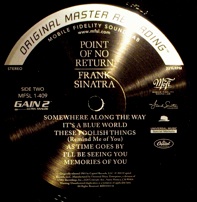Point of No Return - 1962


Mono LP Mix
As readers of these yada yada pages may recall, Come Swing with Me was, in my opinion, a fold-down mono mix. You can dump the mono and stereo original mixes into an audio workstation and A/B the mono mix with the stereo mix, folded, until the cows come home, and there is no difference. Now, whether it is truly a fold-down, or perhaps a concurrently-made mono mix, or some other thing altogether, the end result is: It’s a fold-down, either effectively or literally. It matches. It has the same balances, the same edits, the same tone, the same everything, except maybe a little added compression on the mono cut.
Point of No Return is the same deal. I have no doubt that there is a mono mixdown tape for this LP at Iron Mountain, but it has nothing unique to offer, and if it is not a fold-down, it certainly passes for one, and is, in practice, the same.
iTunes offers up 90 second clips of some songs from Point of No Return, and you can access these free clips by clicking “view” at right, then “View in iTunes.” The clips below are only half that length, and cover the same segment as the free iTunes samples.
These Foolish Things
D4 mono (courtesy “Arkoffs”), then D6 mono, then a fold-down of the 1984 Alan Dell LP
As Time Goes By
D6 mono, followed by a fold-down of an early D5 stereo pressing
I’ll Remember April
A D5 stereo pressing, folded down, followed by a D6 mono pressing
ABOVE FAR RIGHT is a graphic representation of the waveforms for “I’ll Remember April” from eharmonica’s D6 mono pressing and my D5 stereo pressing. Note how much louder (compressed) the mono D6 is than the stereo D5, and the D5 is not the most dynamic of the stereo pressings I have. In fact, the Alan Dell pressing is significantly more dynamic than the USA D5 stereo pressing. BELOW LEFT is a loop showing waveforms for the mono D6 vis a vis the 1984 Alan Dell UK LP:
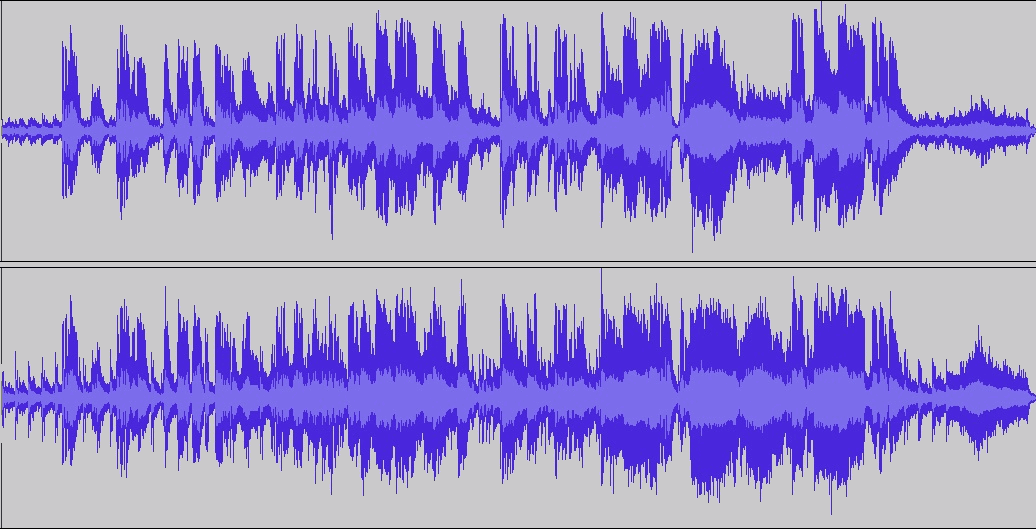
Point being: That mono cut is quite a dynamic-range kick in the shorts compared to the 1984 UK stereo LP. We aren’t talking “subtle differences” here! Using the DR Meter, that’s a “10” on the mono version, and a “12” on the summed-to-mono Dell version. Again: Big difference!
I’m a “pro-mono” guy, so this is not a dig at any of the die-hard mono supporters. (We all “like what we like,” right?) My take on the whole thing is: You can hear the mono mix by buying a mono LP, or you can hear the mono mix by buying the original stereo mix and hitting the mono button or tweaking a digital file. If the stereo mix has as-good-or-better tone and is significantly more dynamic, why not track down the best-sounding copy of the original stereo mix, and, if you want enjoy the mono mix in the best possible way, just hit the mono button while the stereo version plays? Based on eharmonica’s samples, I don’t see how the original mono pressing wins any sort of audiophile prize for sound quality. It may be “nice” or “different” on its own terms -- cool -- but it’s not what I think of as “hi-fi” in the great tradition of Capitol mono product of the era, and aside from its inherent “mono-ness,” it brings nothing unique to the table, unlike the mono mix of, say, Where Are You.
If somebody has a more-dynamic mono pressing, PLEASE contact me so I can get some clips posted!
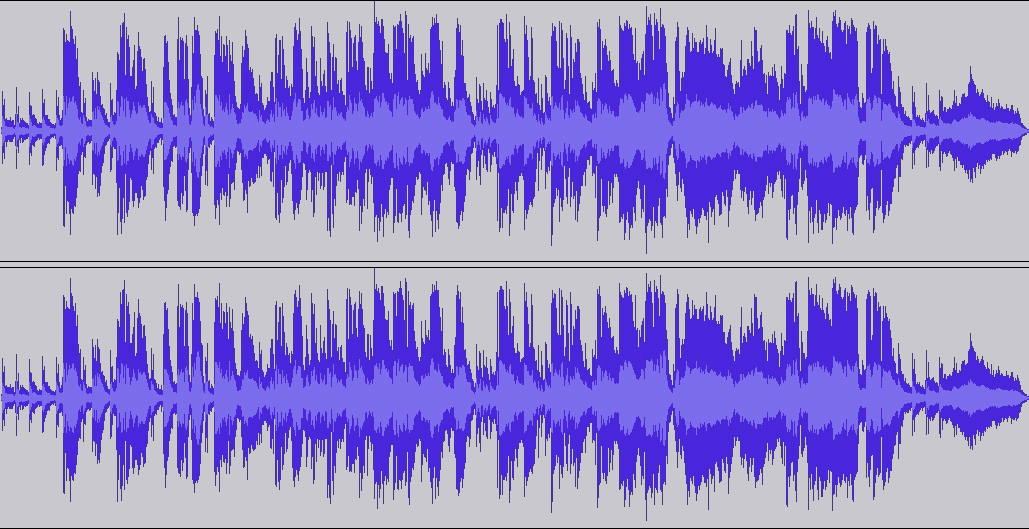
Just to confirm that we are comparing apples to apples, here (in green, below) are the same two (D6 mono, UK Dell), but this time with the Dell as it actually appears when summed to mono:

The point of these mono clips is two-fold: 1.) To allow listeners to hear the mono mix and decide for themselves whether or not they like it; and 2.) to easily compare the mono mix to the stereo mix. Remember: some EQ differences are impossible to avoid, as these are different pressings made on different lathes, but the balances, dynamics, reverb levels, etc., can still be compared.
First up, three samples. The order appears under the photo. Click the photos to hear the sample in WAV format. Mono clips, unless noted otherwise, and label photo are courtesy “eharmonica.” Thanks also to SH.TV’s “Arkoffs.”


For the first time in this ongoing survey of Sinatra LPs, we don’t have a 1983 MFSL pressing, as the album was not issued. There was a test pressing of MFSL #1-144 offered very briefly on Ebay several years ago via a seller in Florida, but the item was quickly pulled and has not been seen since, although I personally saw the sale and can vouch for its apparent existence, so for at least some period of time, the album must have been considered for inclusion in the MFSL box.
That being the case, we do still have some LPs to sample, in 45 second clips: Again, iTunes offers free 90-second clips, which can be heard by clicking “VIEW” (below right), then clicking “View in iTunes” on the page that follows.
For my money, the Dutch DMM, UK, and MFSL are all great sounding stereo LPs, and I am proud to have them all in my collection. The D5 is a good, but not great, LP, with tone quality that is not quite up to the standard set by the others. The UK and Dutch Dell LPs are about 1 to 2 dB more dynamic on each track (RMS measured after peak normalization) than other stereo LPs, even the MFSL, but all sound good. I’d place the top three in this order: 1.) Dutch DMM; 2.) UK Dell LP; 3. MFSL LP. All are within shooting distance of each other, but the MFSL’s less-impressive dynamics drop it a notch for me. I don’t include the excellent sounding SM-series release for the simple reason that it is missing two songs. Sonically, it is quite nice.



Reel-to-Reel Release
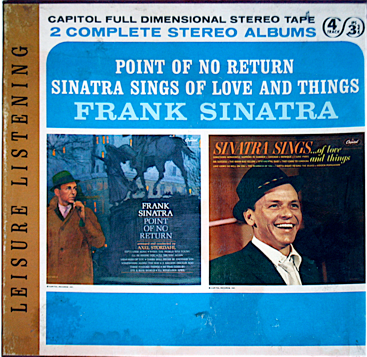

SH.TV member “Loud Listener,” who does some of the most fantastic reel-to-digital transfers you are ever likely to hear, via an Ampex ATR 102 equipped with top-flight 4-track heads, was kind enough to send along a very nice sounding clip from Capitol’s stereo 2-fer reel, #Y2W 2254. It’s interesting to note that we previously sampled the Where Are You tape from this same “Leisure Listening” series, and it was horrid sounding, and “Loud Listener” confirms via e-mail that his copy of the Where Are You 2-fer also has poor sound. That said, the Point of No Return reel is quite nice, especially considering that it’s a 3.75 ips tape, not 7.5. Please have a listen. Click Frank Sinatra - These Foolish Things Reel Clip.wav.
To my ears, the tone quality is very nice, and hiss is not obtrusive. Dynamics are more squished than on the D5 stereo LP. In fact, this track scores a 9 on the DR scale, compared to a 13 for the Dell LP. Here’s the waveform comparison between those two sources (Reel and Dell):
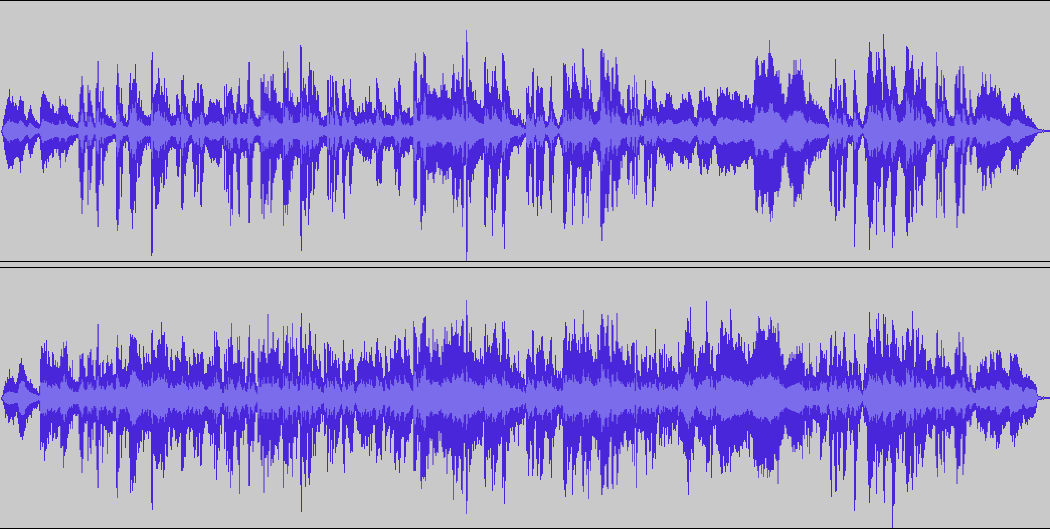
Dynamics aside, that’s a very nice-sounding tape, beautifully transferred to digital. (Thank you for sharing!)
The clips available on this page align with the free samples available via iTunes, linked at left. Click on “VIEW,” then on “View in iTunes.”
These Foolish Things - Click Labels for Audio
Above: D5 USA stereo
Above: 1984 UK stereo
Above: abridged SM-series reissue, courtesy “MMM” and “Loud Listener”
Above: 2014 MFSL stereo LP, mastered by Krieg Wunderlich
Above: 2014 MFSL LP, mastered by Krieg Wunderlich
As Time Goes By - Click Labels for Audio
Above: abridged SM-series reissue, courtesy “MMM” and “Loud Listener”
Above: 1984 UK stereo
Above: D5 USA stereo
Above: 1984 Netherlands DMM LP
Above: 1984 Netherlands DMM stereo LP



